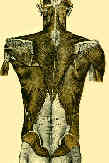- See:

- Anterior Approach Shoulder
- Post Approach to Humerus
- Discussion:
- indicated from frx of the scapula, esp when the pathology is posterior;
- Technique:
- positon the patient in the prone or lateral position;
- skin incision is made starting at the acromial angle and is directed medially and distally either along spine of scapula or alternatively make a verticle
skin incision in the posterior axillary skin crease, extending from posterolateral corner of acromion to the the posterior axillary fold;
- undermine skin flaps to expose the spine of scapula and acromion;
- posterior portion and part of the lateral portion of the deltoid is detached from the spine and from lateral edge of the acromion;
- approach involves splitting deltoid, at junction of its middle & posterior thirds;
- this junction is marked by the posterior corner of the acromion; 
- this site overlies the joint and overlies axillary nerve which exits quadrangular space;
- a stay suture should mark course of axillar nerve;
- the deltoid can be split a distance of approximately 7 cm (below this lies the axillary nerve);
- safe interval to the shoulder is thru the infraspinatus (suprascapular nerve) & teres minor (axillary nerve);
- progressive internal rotation of the humerus will help protect the axillary nerve;
- tendons of infraspinatus and teres minor are exposed w/ the infraspinatus retracted superiorly and the teres minor retracted inferiorly;
- note excessive inferior retraction or inferior dissection may injure axillary nerve which enters the muscle from below;
- the teres minor is incised vertically 2.5 cm from its insertion, allowing exposure of the shoulder joint capsule (be sure not to
injure the capsule during the dissection)
A posterior surgical approach to the proximal part of the humerus.
The posterior deltoid-splitting approach to the shoulder.

